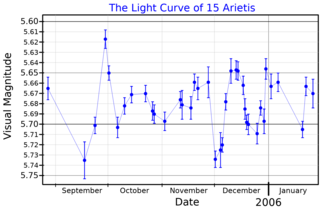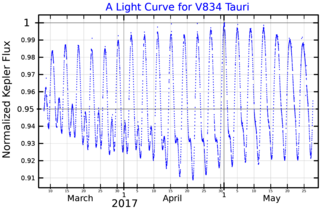Omicron Serpentis is a solitary star in the Serpens Cauda (tail) section of the equatorial constellation Serpens. Based upon an annual parallax shift of 18.83 mas as seen from Earth, it is located around 173 light years from the Sun. The star is visible to the naked eye with a base apparent visual magnitude of +4.26.

Upsilon Ursae Majoris, Latinized from υ Ursae Majoris, is a binary star in the northern circumpolar constellation of Ursa Major. It is visible to the naked eye with an apparent visual magnitude of +3.79. Based upon an annual parallax shift of 13.24 mas, it is located roughly 246 light-years from the Sun.

Omega Virginis is a solitary star in the zodiac constellation Virgo. It has an apparent visual magnitude of +5.2, which is bright enough to be faintly visible to the naked eye. Based upon an annual stellar parallax shift of 6.56 milliarcseconds, it is located about 500 light years from the Sun.

15 Arietis is a single variable star in the northern constellation of Aries. 15 Arietis is the Flamsteed designation; it also bears the variable star designation AV Arietis. It has an apparent visual magnitude of 5.74, which is just bright enough to be visible to the naked eye from dark suburban skies. An annual parallax shift of 5.84 mas corresponds to a physical distance of approximately 560 light-years from Earth. At that distance, the star's brightness is reduced by 0.33 in magnitude because of extinction from interstellar gas and dust.

Iota Canis Majoris, Latinized from ι Canis Majoris, is a solitary variable supergiant star in the southern constellation of Canis Major. It is visible to the naked eye with an apparent visual magnitude that varies between +4.36 and +4.40. The distance to this star is approximately 3,100 light years based on parallax measurements. It is drifting further away with a radial velocity of +41.2 km/s.
Chi Centauri is a star in the constellation Centaurus.

Epsilon Crucis, ε Crucis, also known as Ginan, is a single, orange-hued star in the southern constellation of Crux. Measurements made by the Hipparcos spacecraft showed an annual parallax shift of 14.19 mas, which provides a distance estimate of about 230 light years. The star can be seen with the naked eye, having an apparent visual magnitude of 3.58. It is moving closer to the Sun with a radial velocity of −4.60 km/s.

HD 29697 is a variable star of BY Draconis type in the constellation Taurus. It has an apparent magnitude around 8 and is approximately 43 ly away.
HD 36678 is single star in the northern constellation of Auriga. This star is dimly visible to the naked eye with an apparent visual magnitude of 5.83. It is located at a distance of approximately 840 light years from the Sun based on parallax.

HD 128333 or CH Boötis is an irregular variable star in the northern constellation of Boötes. It is currently on the asymptotic giant branch of the HR diagram.
Nu Herculis, Latinized from ν Herculis, is a binary and variable star in the constellation of Hercules. With an apparent magnitude of about 4.4, it is faintly visible to the naked eye. Parallax measurements made by the Hipparcos spacecraft put it at a distance of about 860 light years.

30 Cygni is a class A5III star in the constellation Cygnus. Its apparent magnitude is 4.83 and it is approximately 610 light years away based on parallax.

Delta Sagittae is a binary star in the constellation of Sagitta, with an apparent magnitude of +3.68. The primary component is a red M-type bright giant, and the secondary is a B-type main-sequence star. It is approximately 430 light years from Earth, based on its Gaia Data Release 2 parallax.
106 Herculis is a variable star in the northern constellation Hercules. It is visible to the naked eye as a faint, red-hued point of light with a baseline apparent visual magnitude of 4.96. Based on its parallax, it is estimated to lie 383 light-years away from the Sun. The star is moving closer to the Earth with a heliocentric radial velocity of -35 km/s.

28 Monocerotis is a single star in the equatorial constellation of Monoceros. It has an orange-hue and is faintly visible to the naked eye with an apparent visual magnitude of 4.69. The distance to this star is approximately 450 light years based on parallax, and it has an absolute magnitude of −1.00. The star is drifting further away from the Sun with a radial velocity of +26.7 km/s.
Mu Muscae, Latinized from μ Muscae, is a solitary star in the southern constellation of Musca. It is visible to the naked eye as a faint, orange-hued star with an apparent visual magnitude of around 4.75. Based upon an annual parallax shift of 7.21 mas as seen from Earth, it is located about 450 light years from the Sun. The star is drifting further away with a radial velocity of +37 km/s.

Omicron1 Orionis is a binary star in the northeastern corner of the constellation Orion. It is visible to the naked eye with an apparent visual magnitude of 4.7. Based upon an annual parallax shift of 5.01±0.71 mas, it is located approximately 650 light years from the Sun. At that distance, the visual magnitude of the star is diminished by an interstellar absorption factor of 0.27 due to intervening dust.

Psi Phoenicis is a star in the constellation Phoenix. Its apparent magnitude varies from 4.3 to 4.5 with a period of about 30 days and it is approximately 342 light years away based on parallax.

Y Centauri or Y Cen is a semiregular variable star in the constellation of Centaurus.

R Leonis Minoris is a Mira variable type star in the constellation Leo Minor. It ranges between apparent magnitude 6.3 and 13.2, and spectral types M6.5e to M9.0e (Tc:), over a period of 372 days.














